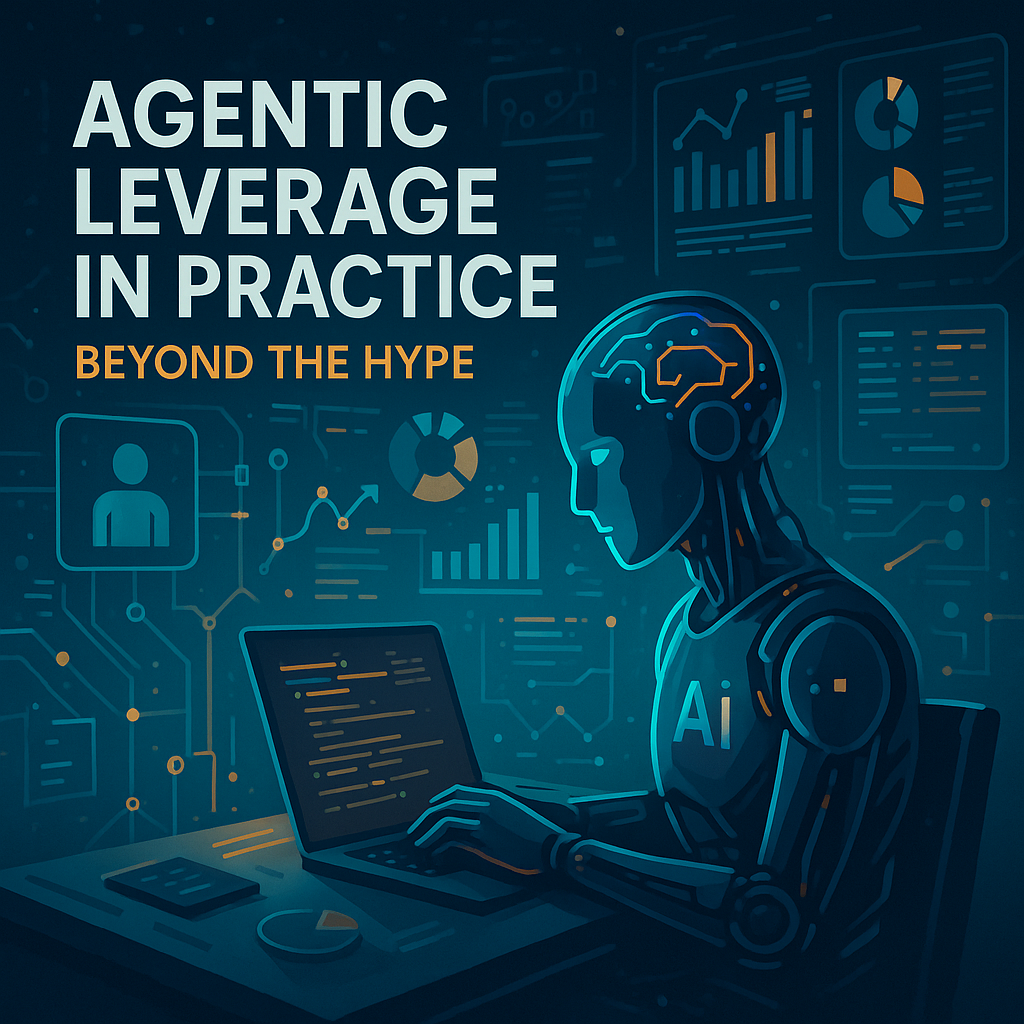Agentic Leverage in Practice: Beyond the Hype
AI agents are having their moment. Every week brings new demos of systems that can write code, analyze data, manage workflows, and even negotiate deals. The promise is compelling: intelligent systems that work autonomously, scaling your capabilities without scaling your team.
But between the demo videos and production reality lies a crucial question: when do AI agents actually create leverage, and when are they just expensive complexity?
What Makes an Agent Actually Useful
The most successful AI agent implementations we've seen share a few key characteristics:
Clear, Constrained Problem Domains
Agents work best when they have well-defined boundaries. Instead of "automate my entire sales process," think "automatically qualify incoming leads based on these specific criteria and route them to the appropriate sales rep."
The constraint isn't a limitation—it's what makes the agent reliable. When you can clearly define the inputs, expected outputs, and edge cases, you can build systems that consistently deliver value.
Human-in-the-Loop Design
The most powerful agents don't replace human judgment—they augment it. They handle the routine work, surface the exceptions, and provide recommendations that humans can quickly review and approve.
This isn't a concession to current technology limitations. It's often the right long-term architecture because it maintains accountability and allows for continuous learning and improvement.
Measurable Business Impact
Before building any agent, ask: "What specific business outcome will this improve, and how will we measure that improvement?" The best implementations target clear metrics: reduced response time, increased lead conversion, lower error rates, or improved customer satisfaction.
If you can't define success metrics upfront, you're probably not ready to build the agent.
Common Anti-Patterns
The "Boil the Ocean" Agent
Trying to automate everything at once. These projects usually fail because the problem space is too complex, the edge cases are too numerous, and the failure modes are too costly.
Better approach: Start with the most repetitive, highest-volume, lowest-risk tasks and expand gradually.
The "Black Box" Agent
Systems that make important decisions without providing clear reasoning or audit trails. This creates compliance risk, makes debugging impossible, and erodes user trust.
Better approach: Design for observability from day one. Every decision should be traceable and explainable.
The "Set and Forget" Agent
Deploying an agent and expecting it to work perfectly forever without maintenance, monitoring, or continuous improvement.
Better approach: Plan for ongoing iteration, monitoring, and human feedback loops.
A Real-World Example
Recently, we helped a professional services firm implement an agent for proposal generation. Instead of trying to automate the entire proposal process, we focused on one specific bottleneck: extracting requirements from RFPs and generating initial project scopes.
The Problem: Senior consultants were spending hours reading through dense RFPs to identify key requirements and estimate project scope—work that was repetitive but required domain expertise.
The Solution: An agent that:
- Parses RFP documents to extract key requirements
- Maps requirements to the firm's service offerings
- Generates initial scope estimates with confidence intervals
- Flags unusual requirements for human review
- Provides a structured summary that consultants can quickly review and refine
The Results:
- 70% reduction in time spent on initial proposal review
- More consistent scoping across different consultants
- Better documentation of assumptions and requirements
- Higher win rate due to faster response times
The Key Insight: We didn't try to replace the consultants' expertise—we gave them a better starting point and more time to focus on strategy and client relationships.
Implementation Guidelines
Start with Process, Not Technology
Before you think about AI agents, map out your current processes. Where are the bottlenecks? What tasks are repetitive? What decisions follow predictable patterns? The best automation opportunities often become obvious once you document what's actually happening.
Build for Iteration
Your first agent won't be perfect. Design systems that can be easily monitored, debugged, and improved. Collect feedback loops from both users and outcomes so you can continuously refine the agent's performance.
Plan for Failure
What happens when the agent makes a mistake? How will you detect failures? What's your fallback process? Building robust error handling and monitoring is often more important than optimizing for the happy path.
Measure Everything
Track not just technical metrics (accuracy, response time, error rates) but business outcomes (cost savings, time savings, quality improvements, user satisfaction). The goal is business leverage, not technical sophistication.
The Strategic Question
The most important question isn't "Can we build an AI agent for this?" but "Should we?"
Consider the total cost of ownership: development time, ongoing maintenance, monitoring overhead, training, and the opportunity cost of not working on something else. Sometimes the best automation is a simple script or a workflow tool, not an AI agent.
But when the problem is right—repetitive, well-defined, high-impact work that requires some intelligence but not deep human judgment—agents can provide genuine leverage.
The key is approaching them as business tools, not technology demonstrations. Start with the business problem, design for reliability and observability, and iterate based on real-world feedback.
Want to explore how AI agents might fit into your specific context? We'd be happy to discuss your use cases and help you identify the best opportunities for agentic leverage. Drop us a line at hello@acmelogicworks.com.
